Mailchimp is one of the most popular automation and email marketing platforms.
And with research revealing that 54 percent of employees believe they could save 240 hours annually through automation, it’s easy to see why businesses are eager to find automation software that meets their needs.
Of course, Mailchimp is hardly the only option. And with the platform announcing a raft of price increases (including an average 11 percent hike in February 2022), it pays to shop around.
Fortunately, there are hundreds of Mailchimp alternatives out there. So many, in fact, that it’s easy to feel overwhelmed by choice.
But don’t worry: we’ve done the hard work for you by rounding up the 10 best Mailchimp alternatives and comparing them across various factors, including:
- Pricing
- Customer support
- Feature sets
The Mailchimp Alternatives Comparison Table
| Mailchimp Alternatives | Best For | Top Features | Pricing/Month |
| Drip | DTC ecommerce | Segment your whole audience based on real-time store, visitor, and marketing data. | From $39/month for up to 2,500 contacts and unlimited email sends. |
| ActiveCampaign | Advanced marketers who need high-level automation | Predictive actions use machine learning to deliver customer experiences based on data, such as the best time to send emails. | From $29/month for one user and unlimited emails. |
| Klaviyo | Ecommerce agencies and developers | Personalization and segmentation tools allow you to create customer segments based on real-time data. | Free for up to 250 contacts and 500 monthly email sends; paid plans priced from $45 per month for up to 1,000 contacts and 10,000 monthly email sends. |
| Omnisend | Ecommerce marketers | Web push notifications allow brands to instantly retarget customers. | Free to reach up to 250 contacts/month, including 500 monthly email sends, up to 60 SMS messages, and up to 500 web push notifications. Paid plans start at $16/month to reach up to 500 contacts (including unlimited push notifications). |
| AWeber | Startups and small businesses | Create email templates in seconds using your website or Facebook page URL. | Free for up to 500 email subscribers; paid plans priced from $16.15/month for up to 2,500 subscribers. |
| ConvertKit | Content creators | Integrated newsletter referral program helps creators grow their reach by leveraging their existing audience. | Free for up to 1,000 subscribers and unlimited email sends; paid plans start at $9/month for up to 300 subscribers and unlimited sends. |
| Sendinblue | Low-budget email marketing | Send transactional emails with guaranteed 97 percent deliverability. | Free for unlimited contacts and up to 300 emails/day. Paid plans start at $25 per month for unlimited contacts and 20,000 emails/month. |
| Constant Contact | Nonprofits and charities | Manage campaigns on the go from a dedicated mobile app. | From $9.99/month for up to 500 contacts and 12,000 monthly email sends. |
| GetResponse | Small businesses that need advanced marketing tools | Built-in support for live and on-demand webinars. | Free for up to 500 contacts and 2,500 monthly email sends. Paid plans start at $15.58/month for 1,000 contacts and unlimited email sends. |
| HubSpot | B2B inbound marketing | Connect marketing, sales, content management, and customer service in a single platform. | Free marketing plan includes unlimited contacts and 2,000 monthly email sends. Paid marketing plans start at $18/month for 1,000 contacts and 5,000 monthly sends. |
The 10 Best Mailchimp Alternatives
1. Drip
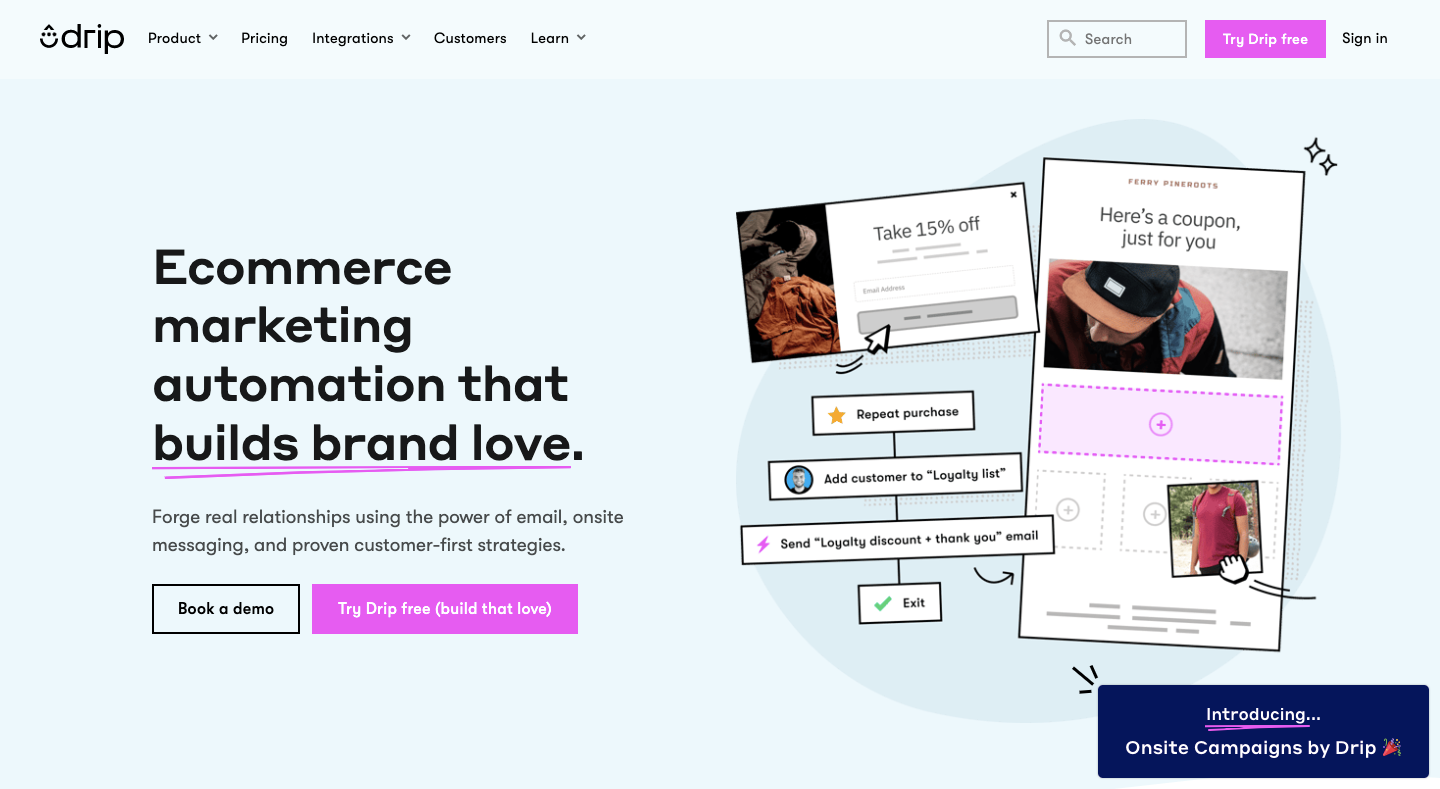 Clearly, we couldn’t write an article about the best Mailchimp alternatives without mentioning our own platform. Drip is a marketing automation platform built specifically for ecommerce brands. We help ecommerce marketers deliver personalized customer journeys at scale through email, onsite, and third-party integrations.
Clearly, we couldn’t write an article about the best Mailchimp alternatives without mentioning our own platform. Drip is a marketing automation platform built specifically for ecommerce brands. We help ecommerce marketers deliver personalized customer journeys at scale through email, onsite, and third-party integrations.
What Makes Drip the Best Mailchimp Alternative?
- Stronger list management and deliverability. Drip’s average ecommerce open rate is 38 percent, compared to just 15.7 percent for Mailchimp. And our deliverability is higher, too (at 99.7 percent, vs. 96 – 99 percent for Mailchimp).
- Advanced ecommerce automations. Drip’s automations are tailored to DTC ecommerce businesses, such as the ability to run seamless multi-channel marketing campaigns from a single automated workflow.
- Built with ecommerce in mind. Unlike Mailchimp, Drip is ecommerce-specific. We integrate with all the major ecommerce platforms and offer pre-built workflows for common ecommerce actions, like cart abandonments and order confirmations.
- Whole-audience segmentation. Mailchimp’s list-based architecture is limiting, with the potential for customers to exist on multiple lists — creating disconnected data and reporting limitations. By contrast, Drip’s powerful segmentation works across your entire audience, allowing you to personalize messaging based on how visitors interact with your store.
- Multichannel workflows. Mailchimp only has email workflows, whereas Drip also allows you to leverage automations across Facebook, Instagram, and Google Ads.
- High-quality ecommerce email templates. Drip offers 50+ professionally designed ecommerce email templates (not including one-click-to-add automation workflow templates), while Mailchimp’s templates are more basic and split across multiple niches.
- Advanced ecommerce support. Our expert in-house customer support team is on hand to give you customized recommendations and ecommerce best practices — including via live audio with screen sharing. Mailchimp only offers generalist support, and you can’t pick up the phone to them unless you’re a Premium customer.
Mailchimp vs Drip: How Does Drip Compare to Mailchimp?
| Drip | Mailchimp | |
| Best Feature | Segment your whole audience based on real-time store, visitor, and marketing data. | Advanced analytics and reporting help marketers make data-driven decisions. |
| Best For | DTC ecommerce | Small businesses |
| Pros | Advanced ecommerce functionality. | Easy-to-learn generalist marketing platform. |
| Cons | If you’re not in ecommerce, Drip likely isn’t the best fit. | Lacks essential ecommerce tools and automations. |
| Pricing/Month | From $39 per month for up to 2,500 contacts and unlimited email sends. | Free for up to 500 contacts and 1,000 monthly email sends; paid plans start at $9.99 per month for 500 contacts and 5,000 monthly email sends. |
| Support | Our support is rated 8.8 on G2 (vs. an average of 8.6 for marketing automation platforms) and includes live audio screen sharing to solve problems in real time. | Paid plans include 24/7 support via chat and email. Phone and priority support is only available to Premium customers paying $350+ per month. |
2. ActiveCampaign
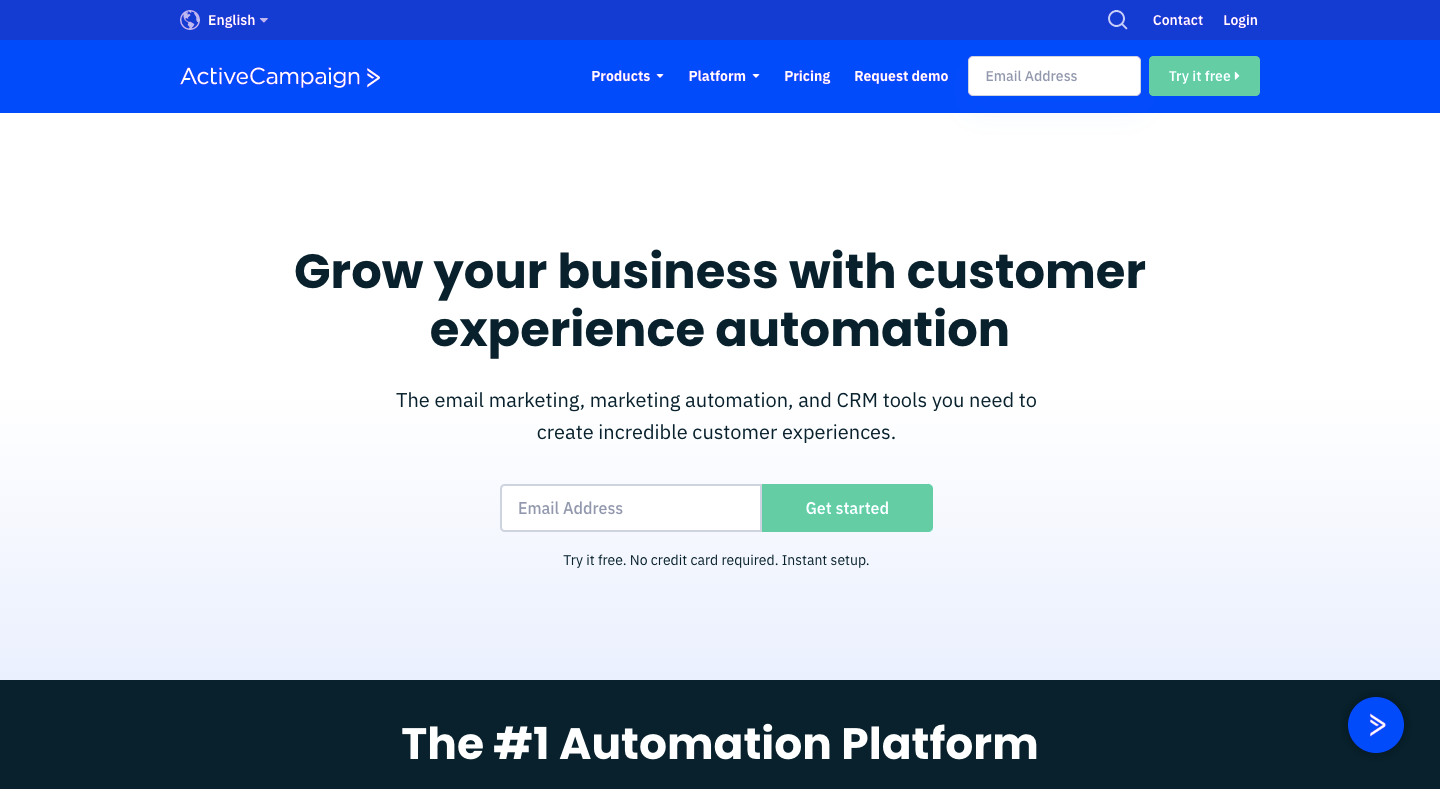 ActiveCampaign is a customer experience automation platform aimed at B2B and B2C businesses across various industries — including ecommerce. Over 150,000 small businesses in 170+ countries use the platform for email marketing, CRM functionality, sales and marketing engagement, and more.
ActiveCampaign is a customer experience automation platform aimed at B2B and B2C businesses across various industries — including ecommerce. Over 150,000 small businesses in 170+ countries use the platform for email marketing, CRM functionality, sales and marketing engagement, and more.
What Makes ActiveCampaign the Best Mailchimp Alternative?
- Sophisticated machine learning. ActiveCampaign integrates machine learning technology to help improve campaign performance over time.
- More marketing channels. While Mailchimp claims to be an all-in-one automation platform, it’s largely focused on email. On the flip side, ActiveCampaign customers can create automated, multichannel user journeys, including SMS, email marketing, and onsite messaging.
- Greater choice of templates. ActiveCampaign offers 250+ high-quality responsive email templates that can be fully customized in just a few clicks. Mailchimp has a much smaller selection—and many look pretty dated.
- Simpler form creation. Whereas ActiveCampaign has a single, easy-to-use visual editor for creating multiple form types, Mailchimp has separate editors for embedded and popup forms.
How Does ActiveCampaign Compare to Mailchimp?
| ActiveCampaign | Mailchimp | |
| Best Feature | Predictive actions use machine learning to deliver customer experiences based on data, such as the best time to send emails. | Advanced analytics and reporting help marketers make data-driven decisions. |
| Best For | Advanced marketers who need high-level automation | Small businesses |
| Pros | Offers functionality across the customer’s lifetime journey, from sales to marketing to support. | Lower pricing, including a free plan for brands with small marketing lists and low activity levels. |
| Cons | Difficult for less-experienced marketers to get to grips with the platform. | More limited functionality and less-sophisticated templates. |
| Pricing/Month | From $29 per month for one user and unlimited emails. | Free for up to 500 contacts and 1,000 monthly email sends; paid plans start at $9.99 per month for 500 contacts and 5,000 monthly email sends. |
| Support | All ActiveCampaign plans offer 24/7 email and chat-based support, but only Enterprise customers get over-the-phone support. | Paid plans include 24/7 support via chat and email. Phone and priority support is only available to Premium customers paying $350+ per month. |
3. Klaviyo
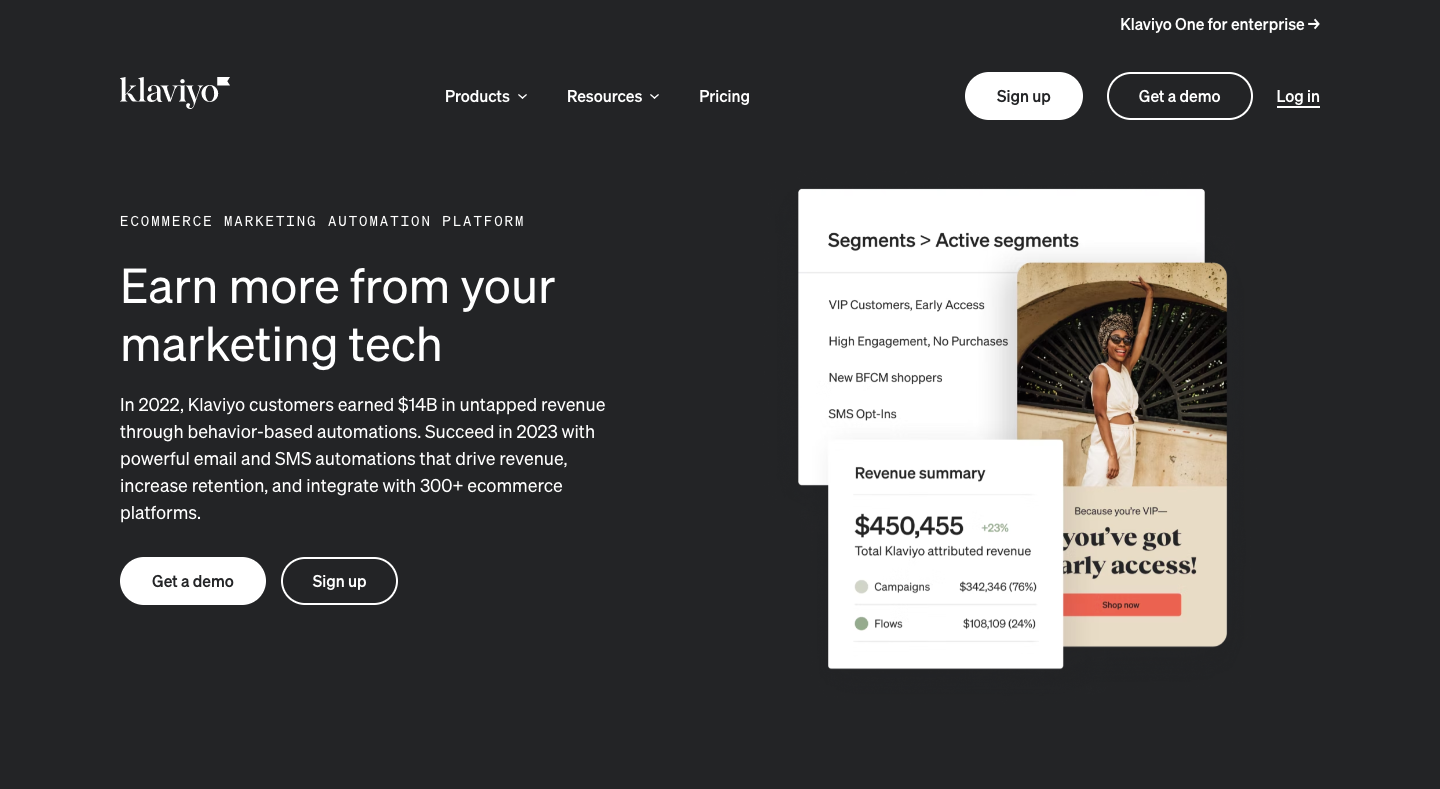 Klaviyo (pronounced “Clay-vee-oh”) is an ecommerce marketing automation platform that allows customers to run automated email and SMS campaigns. Klaviyo is used by 100,000+ paying customers in over 80 countries, ranging from small businesses to Fortune 500 retailers.
Klaviyo (pronounced “Clay-vee-oh”) is an ecommerce marketing automation platform that allows customers to run automated email and SMS campaigns. Klaviyo is used by 100,000+ paying customers in over 80 countries, ranging from small businesses to Fortune 500 retailers.
What Makes Klaviyo the Best Mailchimp Alternative?
- More campaign options. Klaviyo combines email and SMS marketing, helping you reach your audience via the platforms they use most, whereas Mailchimp is email-only.
- Built for ecommerce. Like Drip, Klaviyo is a dedicated ecommerce automation platform, with functionality geared specifically to the ecommerce space. You won’t get that from Mailchimp.
- More pre-built ecommerce automations. Klaviyo offers 60+ pre-built, ecommerce-specific automations—including cart and browse reminders, in-stock alerts, and abandoned cart emails. At the time of writing, Mailchimp only offers a dozen “pre-built journeys”.
- Superior segmentation. Klaviyo lets you get super specific on segmentation, allowing you to target people who buy on certain days, always pay with coupons, or only purchase full-price items. And it integrates with Facebook audience targeting for even deeper segmentation. Mailchimp is far more limited (and doesn’t feature Facebook audience integration).
- Utilize predictive analytics. Klaviyo features data science tools that help you identify people who are likely to become high-spending customers. Mailchimp doesn’t offer anything similar.
How Does Klaviyo Compare to Mailchimp?
| Klaviyo | Mailchimp | |
| Best Feature | Personalization and segmentation tools allow you to create customer segments based on real-time data. | Advanced analytics and reporting help marketers make data-driven decisions. |
| Best For | Ecommerce agencies and developers | Small businesses |
| Pros | Built for ecommerce agencies and developers, with functionality geared specifically to the ecommerce space. | An easy-to-learn generalist email automation platform. |
| Cons | If you’re not in the ecommerce space (or lack the technical chops to leverage the platform), Klaviyo isn’t for you. | Far more basic, especially around segmentation and targeting. |
| Pricing/Month | Free for up to 250 contacts and 500 monthly email sends; paid plans priced from $45 per month for up to 1,000 contacts and 10,000 monthly email sends. | Free for up to 500 contacts and 1,000 monthly email sends; paid plans start at $9.99 per month for 500 contacts and 5,000 monthly email sends. |
| Support | After the extensive onboarding program, support is limited to live chat and emails. | Paid plans include 24/7 support via chat and email. Phone and priority support is only available to Premium customers paying $350+ per month. |
Klaviyo not a Mailchimp alternative that's for you? Check out our other article on Klaviyo alternatives.
4. Omnisend
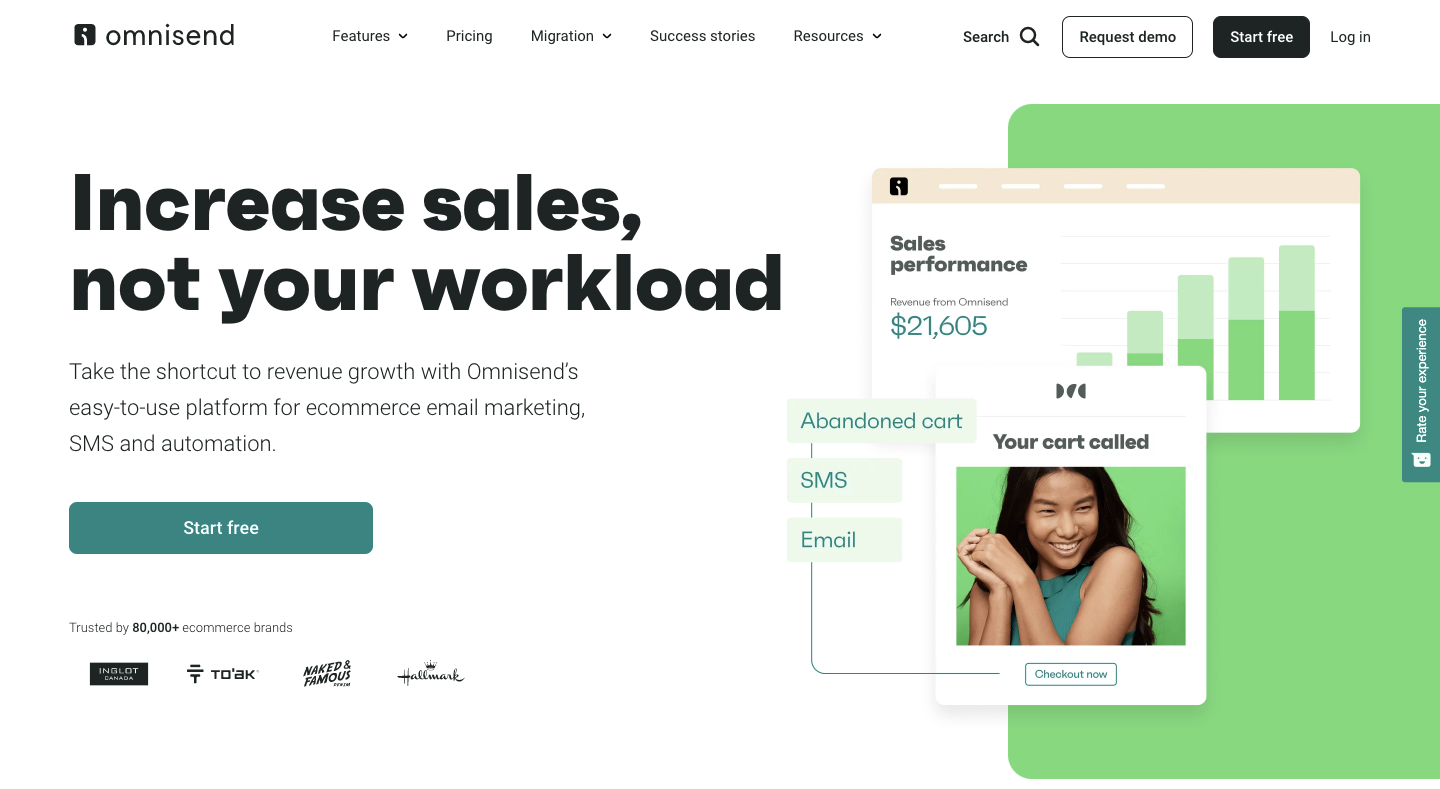 As the name suggests, Omnisend is an omnichannel marketing automation platform. It focuses on the ecommerce space, offering email and SMS marketing functionality to over 80,000 ecommerce brands.
As the name suggests, Omnisend is an omnichannel marketing automation platform. It focuses on the ecommerce space, offering email and SMS marketing functionality to over 80,000 ecommerce brands.
What Makes Omnisend the Best Mailchimp Alternative?
- Leverage multichannel campaigns. Omnisend offers integrated email and SMS campaigns that can be fully customized to your brand and audience, whereas Mailchimp is predominantly an email marketing platform.
- Higher-quality templates. Mailchimp offers more templates, but Omnisend’s are higher-quality—and are available to all customers (even on the free plan). Omnisend also allows you to import HTML templates free of charge.
- More generous free plan. Omnisend’s freemium product tier offers more functionality than Mailchimp’s, including A/B testing, SMS messaging, and web push notifications. Free Omnisend subscribers even get 24/7 email and live chat support.
- Enhanced automation. Mailchimp’s free plan doesn’t include automation, while its entry-level Essentials plan only offers basic, one-step automations. By contrast, Omnisend customers get access to advanced automation on all plans (even the free one), allowing them to set up push notifications, SMS messages, emails, and conditions from the visual flow editor.
- More intuitive form builder. It’s easier to create onsite forms using Omnisend’s form builder. The platform also offers lots of form options, including signup bars, popups, and wheel-of-fortune forms.
How Does Omnisend Compare to Mailchimp?
| Omnisend | Mailchimp | |
| Best Feature | Web push notifications allow brands to instantly retarget customers. | Advanced analytics and reporting help marketers make data-driven decisions. |
| Best For | Ecommerce marketers | Small businesses |
| Pros | Omnisend’s automation tools are easy to use and built with ecommerce marketers in mind. | Mailchimp caters to B2c and B2B businesses, and is just as easy to use. |
| Cons | If you’re not an ecommerce brand, Omnisend ain’t the one. | Subscribers to Mailchimp’s free and entry-level tiers can’t access lots of essential functionality. |
| Pricing/Month | Free to reach up to 250 contacts per month, including 500 monthly email sends, up to 60 SMS messages, and up to 500 web push notifications. Paid plans start at $16 per month to reach up to 500 contacts (including unlimited push notifications). | Free for up to 500 contacts and 1,000 monthly email sends; paid plans start at $9.99 per month for 500 contacts and 5,000 monthly email sends. |
| Support | All users get 24/7 email and live chat support, while Pro and Enterprise subscribers also get a dedicated customer success manager. | Paid plans include 24/7 support via chat and email. Phone and priority support is only available to Premium customers paying $350+ per month. |
5. AWeber
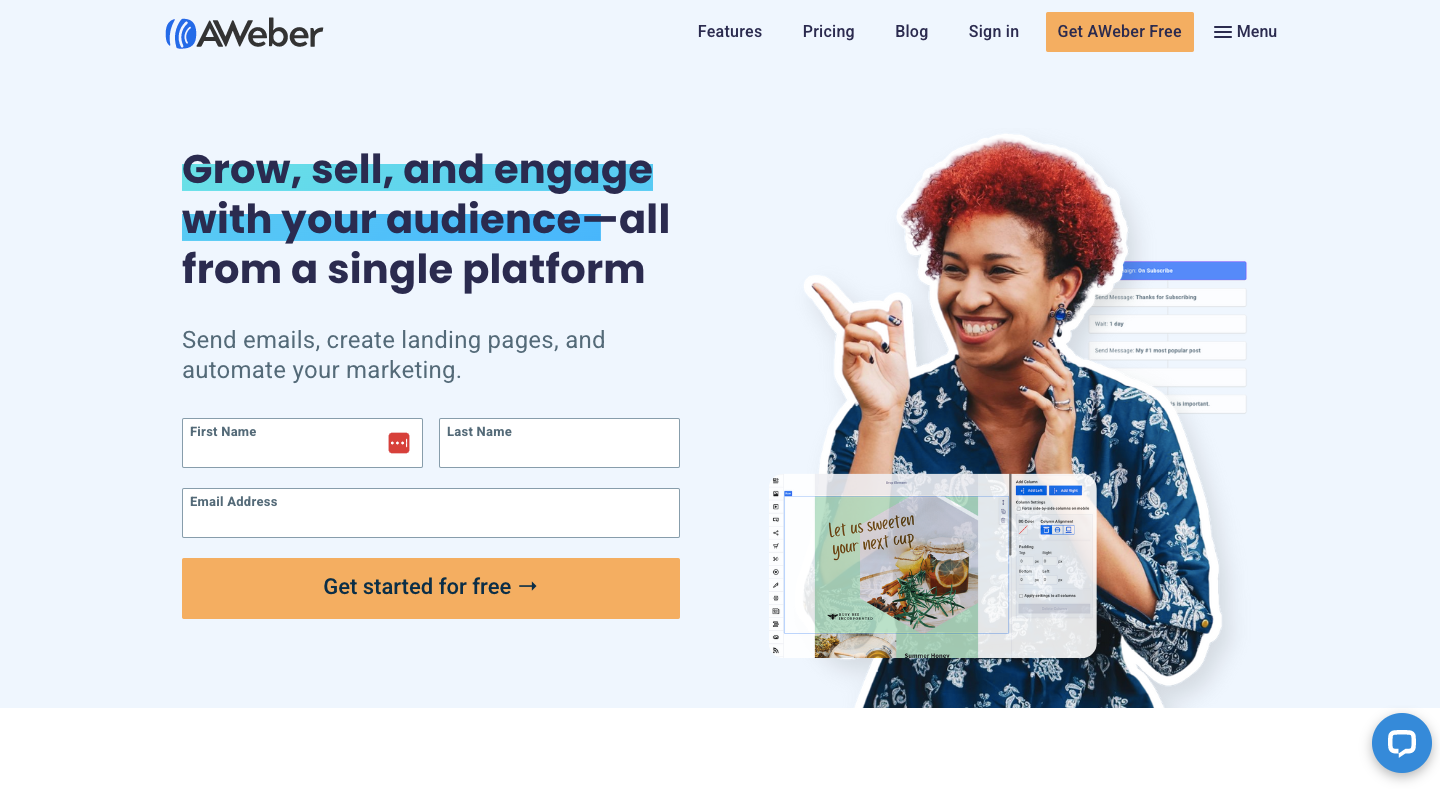 AWeber is a marketing automation platform for small businesses. Customers use AWeber’s tools to send emails, build landing pages, and automate their marketing. It also offers form-building functionality to help users capture audience data.
AWeber is a marketing automation platform for small businesses. Customers use AWeber’s tools to send emails, build landing pages, and automate their marketing. It also offers form-building functionality to help users capture audience data.
What Makes AWeber the Best Mailchimp Alternative?
- More email templates. AWeber offers 600+ email marketing and newsletter templates—about six times more than Mailchimp.
- Greater choice of landing pages. AWeber customers can access dozens of landing page templates, whereas Mailchimp only has 10.
- Improved support options. All AWeber customers get access to 24/7 support via phone, email, and live chat—even if they’re on the platform’s free product tier. Only Premium Mailchimp customers (paying $350+ a month) get phone-based support.
- (Slightly) cheaper price. Both platforms offer decent free product tiers. But when it comes to paid plans, AWeber is slightly more generous. You’ll pay $26.15+ per month for up to 2,500 subscribers, compared to $39.50 with Mailchimp.
How Does AWeber Compare to Mailchimp?
| AWeber | Mailchimp | |
| Best Feature | Create email templates in seconds using your website or Facebook page URL. | Advanced analytics and reporting help marketers make data-driven decisions. |
| Best For | Startups and small businesses | Small businesses |
| Pros | More email and landing page templates. | Includes more advanced functionality, like spam and design testing. |
| Cons | If your marketing list contains 25,000+ subscribers, you’ll need to contact AWeber for a custom quote. | Pricing is based on list size and duplicates contacts who appear in multiple campaigns. |
| Pricing/Month | Free for up to 500 email subscribers; paid plans priced from $16.15 per month for up to 2,500 subscribers. | Free for up to 500 contacts and 1,000 monthly email sends; paid plans start at $9.99 per month for 500 contacts and 5,000 monthly email sends. |
| Support | All users—even free subscribers—can access 24/7 live support via phone, email, and chat (although paying customers are placed in a priority queue). | Paid plans include 24/7 support via chat and email. Phone and priority support is only available to Premium customers paying $350+ per month. |
6. ConvertKit
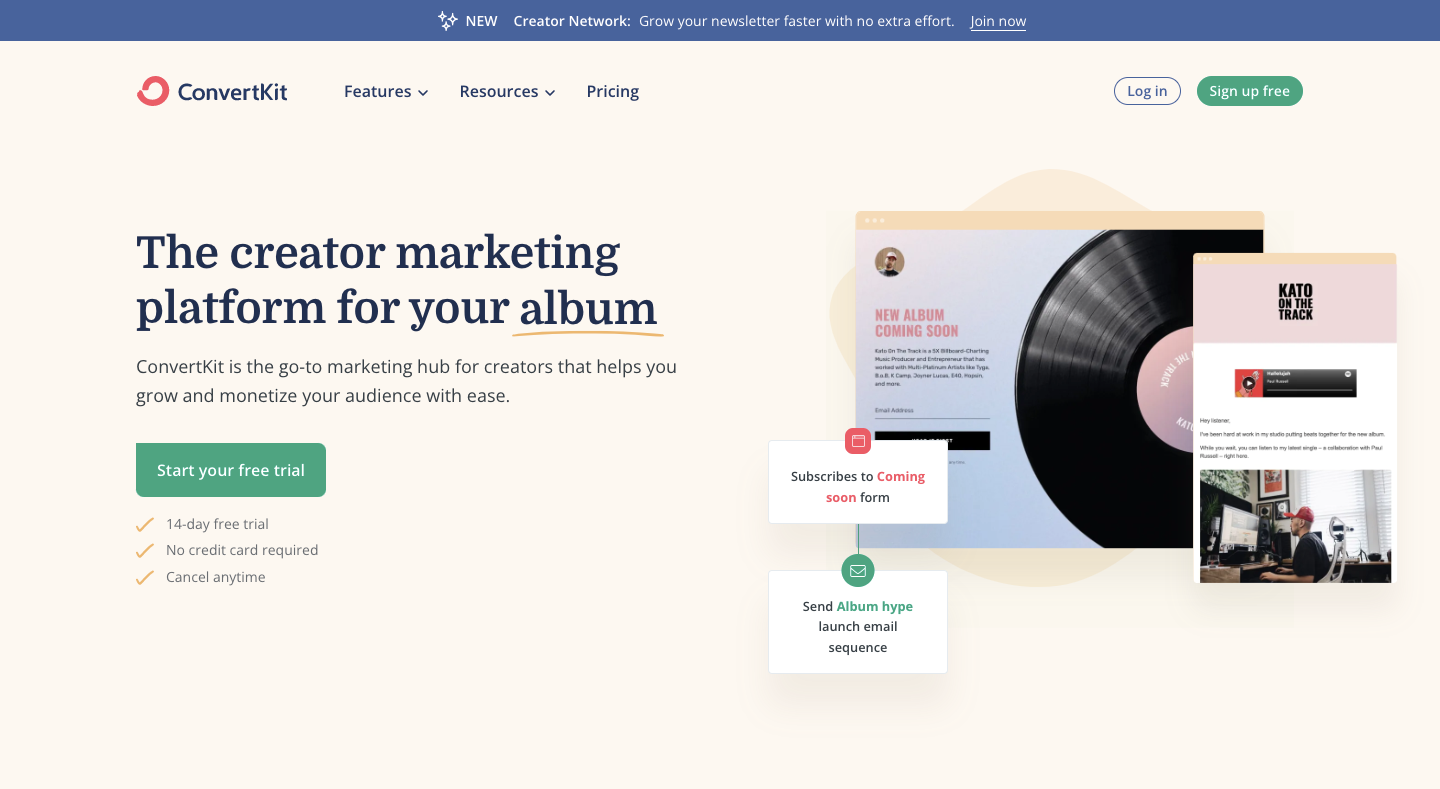 ConvertKit positions itself as a marketing platform for content creators, from podcasters to authors to musicians to coaches. It offers a host of tools, including landing page and form builders, email marketing, and a visual automation builder. Over 560,000 creators have used the platform to reach 600+ million fans and followers.
ConvertKit positions itself as a marketing platform for content creators, from podcasters to authors to musicians to coaches. It offers a host of tools, including landing page and form builders, email marketing, and a visual automation builder. Over 560,000 creators have used the platform to reach 600+ million fans and followers.
What Makes ConvertKit the Best Mailchimp Alternative?
- Higher email deliverability. Mailchimp boasts strong deliverability, at an average of 96 – 99 percent. But it’s still lower than ConvertKit’s superb 99.73 percent deliverability rate.
- Built for content creators. If you’re an author, musician, coach, or podcaster, you’ll be able to leverage ConvertKit’s dedicated tools for content creators. As a generalist platform, Mailchimp doesn’t particularly cater to this niche.
- Simpler list management. ConvertKit allows users to upload contacts to a central hub, then segment them with forms, sequences, and tags. You can even build segments of subscribers with similar characteristics, even if they belong to different forms, sequences, or tags. Mailchimp is more complicated—and it bills double for contacts who appear on two lists.
- More (and better) templates. ConvertKit customers can create simple landing pages based on dozens of attractive templates. It even allows users without websites to build landing pages. Mailchimp offers landing page templates too, but they’re fewer in number and generally lower-quality (in our view).
- More generous freemium options. Both ConvertKit and Mailchimp offer free product tiers. But ConvertKit’s is a touch more generous, allowing up to 1,000 subscribers and unlimited email sends, compared to 500 contacts and 1,000 monthly sends for Mailchimp.
How Does ConvertKit Compare to Mailchimp?
| ConvertKit | Mailchimp | |
| Best Feature | Integrated newsletter referral program helps creators grow their reach by leveraging their existing audience. | Advanced analytics and reporting help marketers make data-driven decisions. |
| Best For | Content creators | Small businesses |
| Pros | Stronger email deliverability (at 99.73 percent on average). | Includes more advanced functionality, like spam and design testing. |
| Cons | Very basic reporting, with no bounce rate, geographical data, or click maps. | Fewer templates and a less-generous free product tier. |
| Pricing/Month | Free for up to 1,000 subscribers and unlimited email sends; paid plans start at $9 per month for up to 300 subscribers and unlimited sends. | Free for up to 500 contacts and 1,000 monthly email sends; paid plans start at $9.99 per month for 500 contacts and 5,000 monthly email sends. |
| Support | Paying customers get live chat and email support, with priority access offered to Creator Pro subscribers. Free subscribers only get community support. | Paid plans include 24/7 support via chat and email. Phone and priority support is only available to Premium customers paying $350+ per month. |
7. Sendinblue
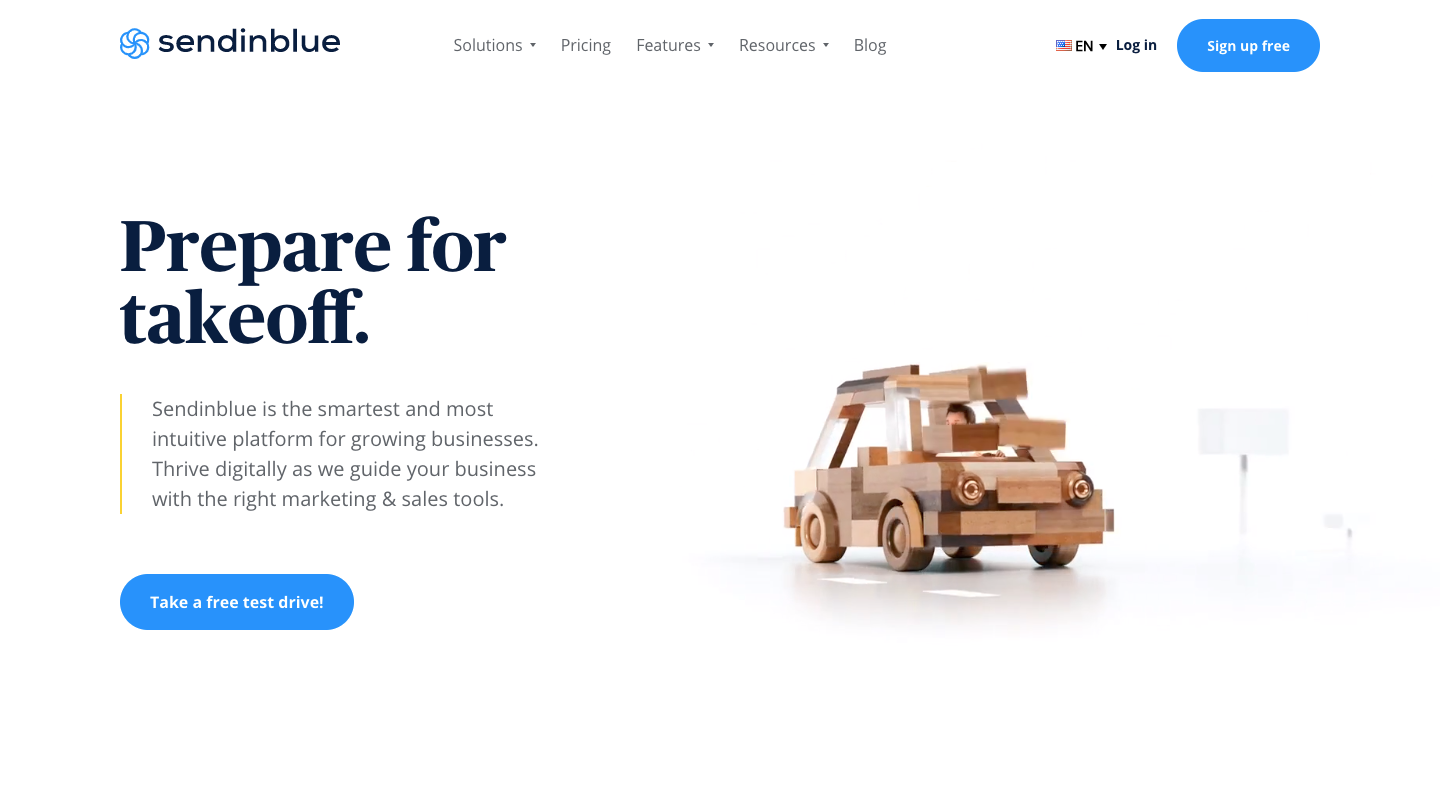 Sendinblue is an all-in-one marketing platform incorporating email, SMS, WhatsApp, lead capture forms, Facebook Ads, landing pages, and marketing automation. Half a million customers in 180 countries use the platform to send a combined 200 million emails every day.
Sendinblue is an all-in-one marketing platform incorporating email, SMS, WhatsApp, lead capture forms, Facebook Ads, landing pages, and marketing automation. Half a million customers in 180 countries use the platform to send a combined 200 million emails every day.
What Makes Sendinblue the Best Mailchimp Alternative?
- Enhanced list management. Mailchimp customers often complain about list management, with no option to add contacts to multiple lists in the same campaigns. By contrast, Sendinblue’s list management is intuitive and can be easily automated, meaning new subscribers can be automatically added to one or more lists based on their actions.
- More generous free plan. Sendinblue’s free product tier is one of the most generous on the market, offering up to 300 emails per day with unlimited contacts. Mailchimp’s is pretty stingy by comparison, with only 500 contacts and 1,000 monthly email sends.
- More advanced automations at lower tiers. Mailchimp offers a ton of automations, but the most advanced stuff is only available on the higher Standard and Premium plans. On the other hand, Sendinblue’s automation features—including lead scoring and pre-launch campaign testing — are even available to free users (although they’re limited to 2,000 contacts on the free and Starter plans).
- More ways to reach your audience. Whereas Mailchimp is all about email marketing, Sendinblue allows you to target customers via email, WhatsApp, and SMS — even on its lowest product tiers.
- Built-in CRM. Unlike Mailchimp, Sendinblue has a dedicated CRM, making it easier for users to manage their sales pipelines.
How Does Sendinblue Compare to Mailchimp?
| Sendinblue | Mailchimp | |
| Best Feature | Send transactional emails with guaranteed 97 percent deliverability. | Advanced analytics and reporting help marketers make data-driven decisions. |
| Best For | Low-budget email marketing | Small businesses |
| Pros | Extremely generous free product tier, including unlimited contacts and up to 300 emails per day. | Stronger reporting, including ecommerce and social media reports. |
| Cons | Offers fewer integrations than Mailchimp. | Lower-tier plans offer fewer features than Sendinblue’s. |
| Pricing/Month | Free for unlimited contacts and up to 300 emails per day. Paid plans start at $25 per month for unlimited contacts and 20,000 emails per month. | Free for up to 500 contacts and 1,000 monthly email sends; paid plans start at $9.99 per month for 500 contacts and 5,000 monthly email sends. |
| Support | The $25+ per month Starter plan only offers email-based support. To receive personalized support, you’ll need to subscribe to an Enterprise plan. | Paid plans include 24/7 support via chat and email. Phone and priority support is only available to Premium customers paying $350+ per month. |
8. Constant Contact
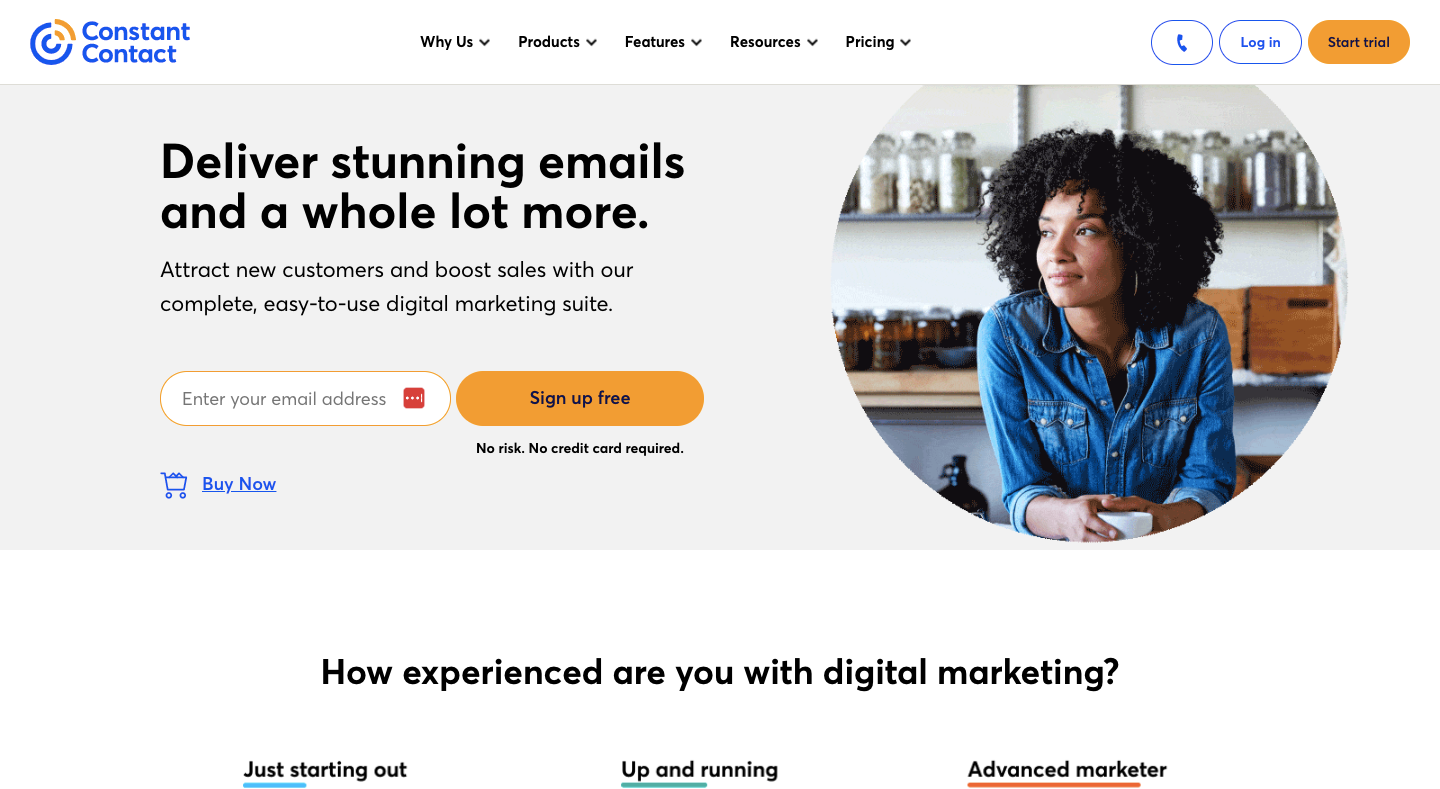 Constant Contact is a digital marketing platform incorporating email, SMS, social media, and automation. It predominantly targets small businesses in various industries. But it’s arguably best suited to nonprofits as it offers them a healthy discount on prepaid plans.
Constant Contact is a digital marketing platform incorporating email, SMS, social media, and automation. It predominantly targets small businesses in various industries. But it’s arguably best suited to nonprofits as it offers them a healthy discount on prepaid plans.
What Makes Constant Contact the Best Mailchimp Alternative?
- More email templates. Constant Contact offers 200+ email templates — about twice as many as Mailchimp. Its templates are segmented into useful categories, such as retail and holiday-themed newsletters.
- More email sends for your buck. All Constant Contact packages have a monthly email send limit of 24X your total contacts. So if you’ve got 2,500 contacts, your send limit is 60,000 emails a month. At the same price point, Mailchimp only offers 25,000 monthly email sends.
- More points of contact. Provided you’re based in the US, Constant Contact lets you add SMS marketing to its paid plans from $10 per month, giving you an additional way to reach your audience.
- Bigger discounts for nonprofits. Both Mailchimp and Constant Contact offer discounted rates for charities and nonprofits. But Constant Contact’s is more generous: nonprofits get a 30 percent discount when they prepay for 12 months, compared to Mailchimp’s 15 percent discount.
How Does Constant Contact Compare to Mailchimp?
| Constant Contact | Mailchimp | |
| Best Feature | Manage campaigns on the go from a dedicated mobile app. | Advanced analytics and reporting help marketers make data-driven decisions. |
| Best For | Nonprofits and charities | Small businesses |
| Pros | Higher email send limits. | More integrations and a generous free plan. |
| Cons | More limited reporting, with no geo tracking, click maps, or social media reports. | No support for SMS marketing. |
| Pricing/Month | From $9.99 per month for up to 500 contacts and 12,000 monthly email sends. | Free for up to 500 contacts and 1,000 monthly email sends; paid plans start at $9.99 per month for 500 contacts and 5,000 monthly email sends. |
| Support | Both paid plans offer live chat and phone support, while Constant Contact Plus subscribers also get personalized consultations to improve performance. | Paid plans include 24/7 support via chat and email. Phone and priority support is only available to Premium customers paying $350+ per month. |
9. GetResponse
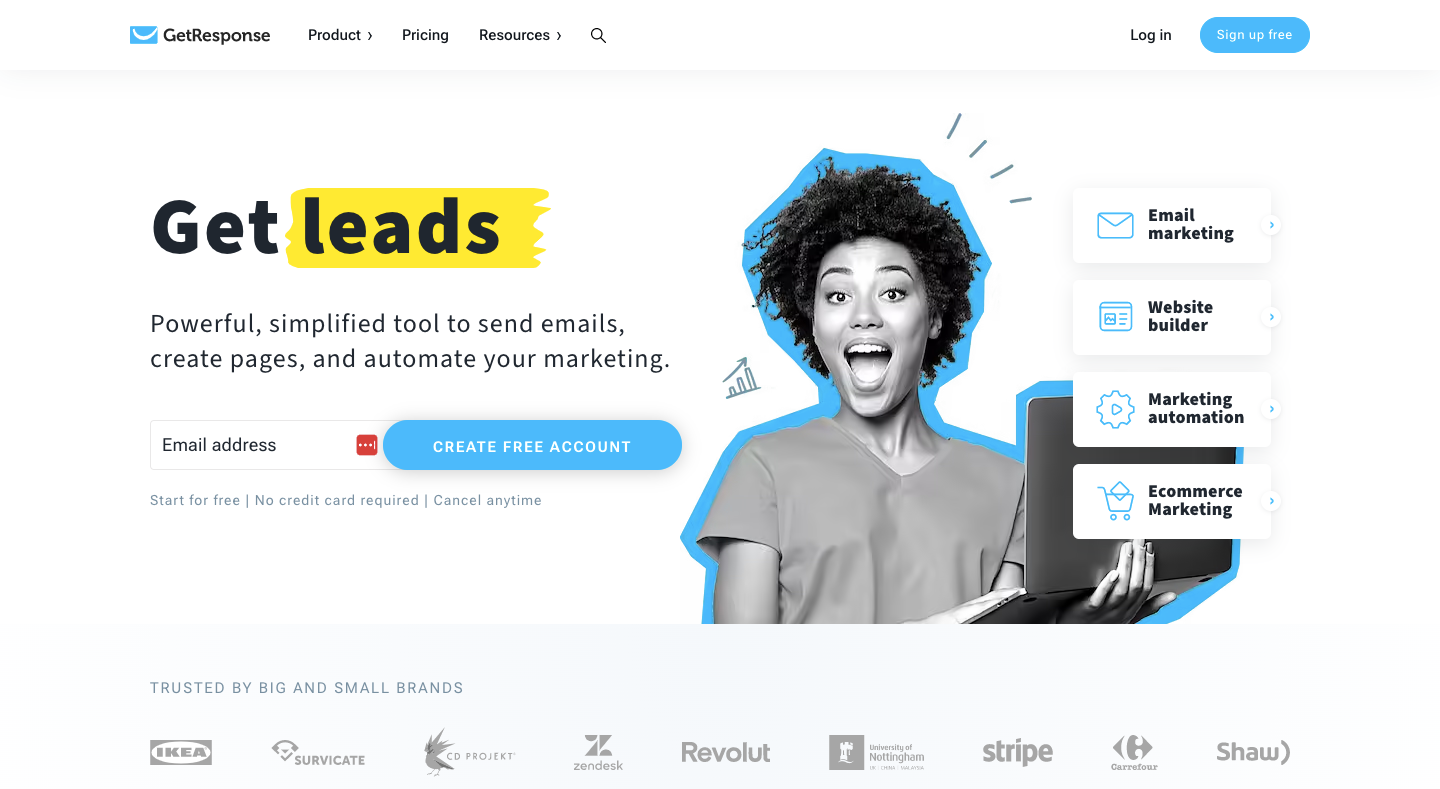 GetResponse is first and foremost an email marketing platform, but higher-paying customers can also access automation, SMS marketing, web push notifications, and a bunch of other features. Over 350,000 businesses use GetResponse, including big names like Ikea, Stripe, and Zendesk.
GetResponse is first and foremost an email marketing platform, but higher-paying customers can also access automation, SMS marketing, web push notifications, and a bunch of other features. Over 350,000 businesses use GetResponse, including big names like Ikea, Stripe, and Zendesk.
What Makes GetResponse the Best Mailchimp Alternative?
- Higher-quality templates. Both Mailchimp and GetResponse offer 100+ email templates. But GetResponse’s highest-quality templates are available to all users, whereas lower-tier Mailchimp customers only get access to basic (and somewhat outdated) templates.
- More generous free plan. Again, both platforms offer a free-for-life product tier. But with GetResponse, you get up to 500 contacts and 2,500 monthly email sends—plus lots of other good stuff, like click tracking and an HTML editor.
- More sophisticated list management. Unlike Mailchimp, GetResponse doesn’t silo your contacts, so you can copy or move them to different campaigns. And you won’t be charged twice if a contact exists in two campaigns.
- Multi-language support. GetResponse and Mailchimp are both truly global platforms, so it’s helpful that GetResponse offers email support in eight languages. That’s over twice as many as Mailchimp.
- Better access to spam testing. All GetResponse users get access to spam and design testing, helping more of your messages land in the main inbox. Mailchimp only offers design testing at higher price points or as a third-party service — and doesn’t do spam testing at all.
- More options for forms and popups. GetResponse offers a huge library of website form and popup templates, plus an easy-to-use drag-and-drop tool to create your own designs. Mailchimp’s form and popup options are more limited and harder to use.
- Integrated webinar hosting. GetResponse offers built-in webinar hosting with its Marketing Automation, Ecommerce Marketing, and MAX2 price plans. You don’t get that with Mailchimp.
How Does GetResponse Compare to Mailchimp?
| GetResponse | Mailchimp | |
| Best Feature | Built-in support for live and on-demand webinars. | Advanced analytics and reporting help marketers make data-driven decisions. |
| Best For | Small businesses that need advanced marketing tools | Small businesses |
| Pros | More sophisticated features, like webinar hosting, spam testing, and stronger list management. | Slightly stronger reporting, including built-in social media reports. |
| Cons | Entry-level paid plan doesn’t offer marketing automation. | Lacks some useful functionality, including spam testing. |
| Pricing/Month | Free for up to 500 contacts and 2,500 monthly email sends. Paid plans start at $15.58 per month for 1,000 contacts and unlimited email sends. | Free for up to 500 contacts and 1,000 monthly email sends; paid plans start at $9.99 per month for 500 contacts and 5,000 monthly email sends. |
| Support | Paid plans include 24/7 support via chat and email. Phone support is only available at top-tier MAX2 level; some MAX2 customers can also access Slack support. | Paid plans include 24/7 support via chat and email. Phone and priority support is only available to Premium customers paying $350+ per month. |
10. HubSpot
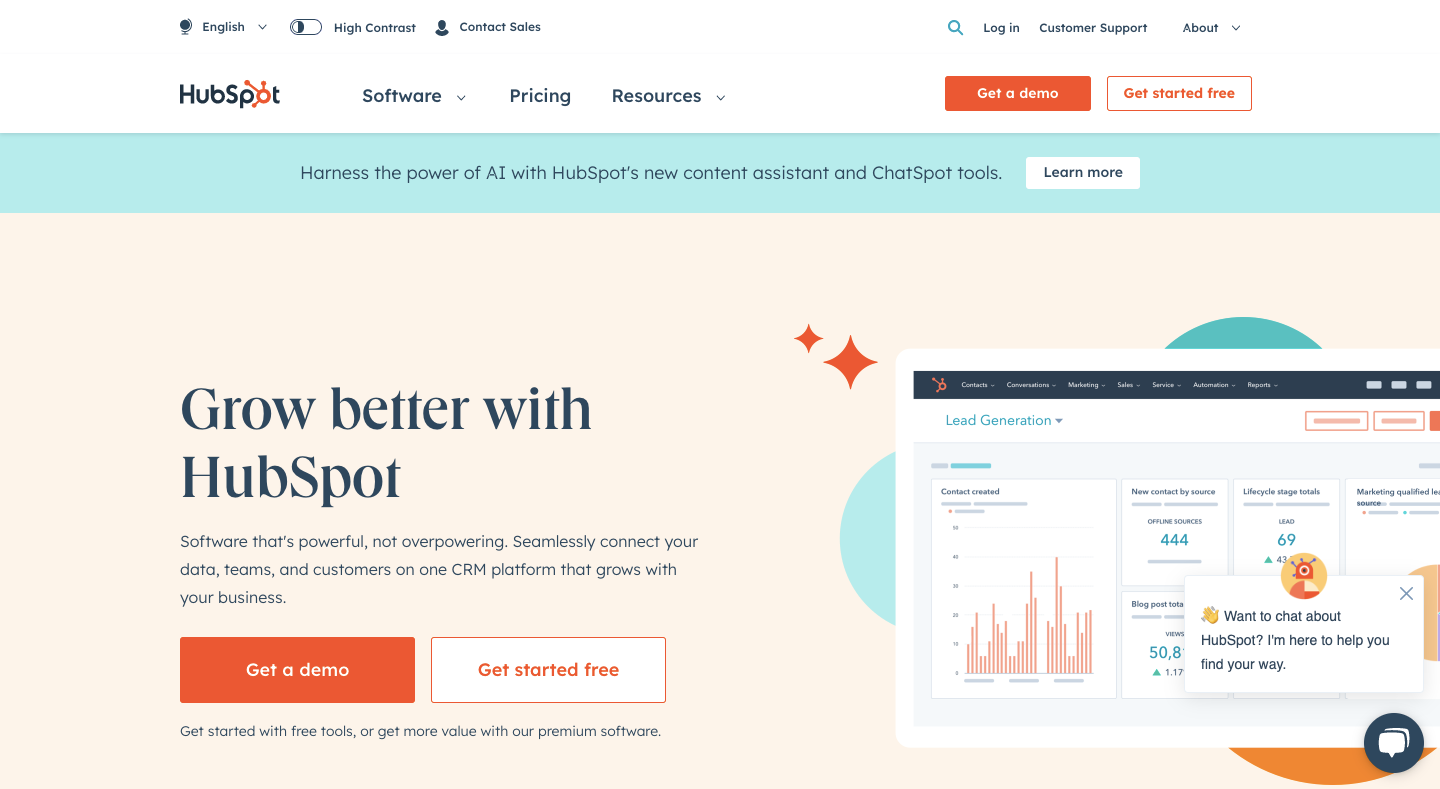 HubSpot is a CRM platform that also offers email marketing, automation, landing pages, and content marketing functionality. Its marketing, sales, service, CMS, and operations products are available as standalone subscriptions, or can be combined to create an all-in-one inbound marketing platform. HubSpot has 167,000+ customers in over 120 countries, including household names like DoorDash and Soundcloud.
HubSpot is a CRM platform that also offers email marketing, automation, landing pages, and content marketing functionality. Its marketing, sales, service, CMS, and operations products are available as standalone subscriptions, or can be combined to create an all-in-one inbound marketing platform. HubSpot has 167,000+ customers in over 120 countries, including household names like DoorDash and Soundcloud.
What Makes HubSpot the Best Mailchimp Alternative?
- Much more than email marketing. Mailchimp is first and foremost an email marketing platform, whereas HubSpot does so much other stuff. If you want an all-in-one platform, Mailchimp can’t compete.
- More generous free plan. Any free functionality is better than none, but HubSpot’s free marketing plan offers unlimited contacts, twice as many monthly email sends, and additional functionality like conversational chatbots and ad retargeting.
- A/B testing on landing pages. Both platforms feature landing page builders. But only HubSpot offers A/B testing on landing pages—vital for improving conversion rates.
- Every integration you can imagine. Mailchimp offers hundreds of integrations. But it can’t match HubSpot, which offers 1,000 integrations across marketing, sales, customer service, finance, and productivity.
- More reporting options. Again, Mailchimp’s reporting and analytics is excellent, but HubSpot simply offers more options. Even free plan subscribers get up to three reporting dashboards, each containing up to 10 reports.
- Built-in social media posting. At Marketing Hub Professional level, HubSpot users can connect up to 50 social media accounts, create 10,000 posts per month, and schedule up to three years in advance. Mailchimp can’t do any of that.
How Does HubSpot Compare to Mailchimp?
| HubSpot | Mailchimp | |
| Best Feature | Connect marketing, sales, content management, and customer service in a single platform. | Advanced analytics and reporting help marketers make data-driven decisions. |
| Best For | B2B inbound marketing | Small businesses |
| Pros | Does a lot more than just email marketing. | An easy-to-learn email marketing platform. |
| Cons | Learning curve can be extremely steep. | No social media scheduling, landing page testing, or other advanced features. |
| Pricing/Month | Free marketing plan includes unlimited contacts and 2,000 monthly email sends. Paid marketing plans start at $18 per month for 1,000 contacts and 5,000 monthly sends. | Free for up to 500 contacts and 1,000 monthly email sends; paid plans start at $9.99 per month for 500 contacts and 5,000 monthly email sends. |
| Support | Paying customers can get 1:1 email and in-app chat support. Phone support is available at Pro level and above. | Paid plans include 24/7 support via chat and email. Phone and priority support is only available to Premium customers paying $350+ per month. |
Frequently Asked Questions
Are There Better Alternatives to Mailchimp?
There are many better alternatives to Mailchimp. Popular Mailchimp alternatives for ecommerce marketers include Drip, Klaviyo, and Omnisend, while the likes of ActiveCampaign and Sendinblue offer more generalist email marketing platforms. And if you’re looking for an all-in-one solution, HubSpot is hard to beat.
Does Google Have a Mailchimp Alternative?
Google doesn’t have its own email marketing offering. However, there are various apps that effectively turn Gmail into an email marketing service—albeit without some of the more advanced features of a dedicated platform.
Is Mailchimp the Best Email?
Mailchimp is a solid email marketing platform with a decent free plan and excellent reporting options. However, it’s not necessarily the “best” option. There are lots of high-quality Mailchimp alternatives out there. Some offer more industry-specific features; some are cheaper; some offer extra functionality, like landing page A/B testing or more sophisticated automation. Choosing the “best” platform will depend on your marketing goals and the needs of your business.
What Are the Disadvantages of Mailchimp?
Mailchimp has a few notable disadvantages. For instance, its workflows are inflexible and email-only, excluding platforms like Facebook and Instagram. Although it offers a ton of integrations, it has a rocky relationship with Shopify. And its list-based architecture is limiting, with customers appearing on multiple lists — leading to reporting challenges and disconnected data.
Conclusion
Ultimately, there’s no way to confidently answer the question: “What is the best Mailchimp alternative?”
The best Mailchimp option depends on your specific requirements:
- Do you just want email marketing or an all-in-one platform?
- Are you looking for an ecommerce-specific platform or something more “general”?
- Are you prepared to cope with a steep learning curve in return for advanced tools?
However, if you’re a DTC ecommerce marketer looking for a marketing automation tool built specifically for businesses like yours, we truly believe Drip is your best choice.
Best of all, you can find out for yourself by signing up for your 14-day free trial today.


